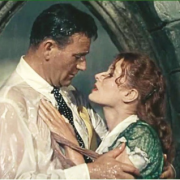The Quiet Man – made the year I was born!
My most basic reference point concerns surely one of the best-loved films ever to come out of Hollywood? The Quiet Man was made in 1951 (released in 1952) which was the year I was introduced to this world.
I make no apology for indulging in a bit of nostalgia – it’s nice to take any opportunity to promote something I’ve grown up with and returned to time and time again.
But what has a 1952 film got to do with a blog about writing? Bear with me, please, and I’ll get there.
Directed by John Forde (who got the Best Director Oscar for it) and starring John Wayne, Maureen O’Hara, Victor McLaglen, and Barry Fitzgerald (who was cruelly overlooked for Best Supporting Actor) the film is a glimpse into an old Ireland that is perhaps glamourised and typecast, but one we all imagine is deep in our roots.
I did a bit of rummaging around and found a wonderful tribute by Reel Classics, which described the film as “storytelling at its finest – transparent, unpretentious and beautiful”.
Imagine the breathtaking scenery of the West of Ireland; the trapped-in-time quaintness of the village of Cong, where the film was centred) and the reclusive luxury of the Ashford Castle estate, where many memorable scenes were staged, and you just have to get yourself there, if an opportunity arises.
You can’t call yourself Irish or Irish American unless you undertake The Quiet Man pilgrimage to a corner of the world that is truly blessed. Me? I’ve visited the area and done the tours more than twenty times – but then I’m a self-confessed, hopeless romantic.
Right, that’s my bit done for Bord Failte (the Irish Tourist Board). Now the reasons for highlighting this cinematic diamond.
The Quiet Man first appeared in 1933 as a short story by Maurice Walsh. It was published in the Saturday Evening Post, a bimonthly American journal, popular as a shop window for budding novelists. Walsh sold the rights of the story to Forde later that year for the princely sum of $10. It was at heart a simple story of human relationships, though it grew to represent much more by the time Forde brought it to the big screen almost 20 years later.
In total, Walsh’s short was exactly 7,000 words – that’s right, I checked! Although the names of all the original Walsh characters were changed later by the screenwriters, the film keeps faith with the overall storyline.
I was fascinated by the change in the opening paragraph. Here’s what Walsh wrote:
Shawn Kelvin, a blithe young lad of 20, went to the States to seek his fortune. And 15 years thereafter he returned to his native Kerry, his blitheness sobered and his youth dried to the core, and whether he had made his fortune or whether he had not no one could be knowing for certain. For he was a quiet man, not given to talking about himself and the things he had done.
And here’s what screenwriters Frank S. Nugent and Richard Llewellyn came up with for the film:
A fine soft day in the spring, it was, when the train pulled into Castletown, three hours late as usual, and himself got off. He didn’t have the look of an American tourist at all about him. Not a camera on him; what was worse, not even a fishin’ rod.
I don’t know about the rest of you, but either version would have me wanting to read on.
What lies at the heart of Walsh’s story is a simple tale of a man returning to his roots and falling in love with a local girl. He has to win her affections and then battle her brother’s redneck prejudices before they can have a life together. An inevitable showdown between the hero and his brother-in-law eventually becomes unavoidable.
It’s a straightforward tale, easy to describe, and easy to build a frame around.
It can be a bit like that for all stories. Even the most convoluted thriller, or detective whodunnit, starts with a basic outline that can be quickly summarised, in much the same way as we try to provide readers with a flavour on our dustsheet summaries.
The real work of an author begins when he/she has to overlay their story with settings, scenery, character descriptions, and actions.
Subplots come next – those twists and turns that take the reader temporarily away from the main story, but which enhance enjoyment and experiences as our characters embark on the story’s journey.
My advice to new authors is to keep true to the above formula. If you can’t summarise succinctly what your story is about, then maybe you should be thinking of writing a different story!
First see the path clearly and uncluttered from A to Z before you start to add the bells, whistles, and little pink ribbons.
Look what Maurice Walsh did with a short story. Look how the screenwriters turned it into a full-length novel.
The choice is yours, but the principle is sound – the basic skeleton of your tale is what’s important. Get it right and it will always be there for you to fall back on when you lose your way down the side roads of sub-plotting.
FOOTNOTE: Here’s an interesting snippet about The Quiet Man. The final scene of the film shows Maureen O’Hara whisper something into John Wayne’s ear. It’s clearly unscripted and there’s genuine shock in Wayne’s face as he reacts to the words. It has been the subject of wild conjecture ever since. According to O’Hara, only Wayne, Forde and she know what she said, and she’s not for telling.
Anyone got any suggestions?





Leave a Reply
Want to join the discussion?Feel free to contribute!